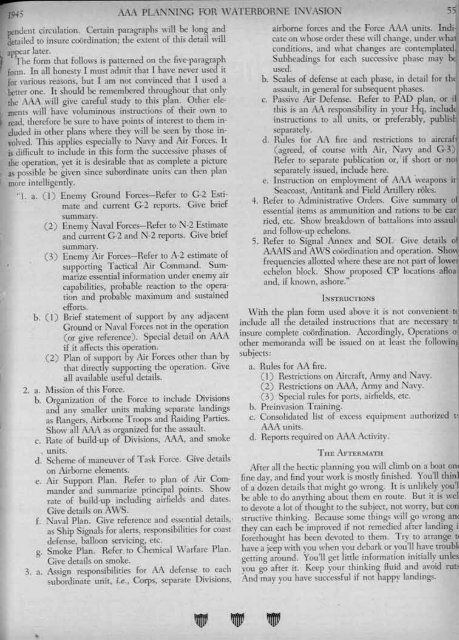September-October - Air Defense Artillery
September-October - Air Defense Artillery
September-October - Air Defense Artillery
You also want an ePaper? Increase the reach of your titles
YUMPU automatically turns print PDFs into web optimized ePapers that Google loves.
;;.f5 AAA PLANc.JING FOR \VATERBORNE INVI\SION 55<br />
pendent circulation. Certain paragraphs will be long and airborne forces and the Force AM units. Indi-<br />
detailed to insure coordination; the extent of this detail will cate on whose order these will chanoe under what<br />
" '<br />
appear later. conditions, and what changes are contemplated.<br />
The fonn that follows is patterned on the five-paragraph Subheadings for each successive phase may be<br />
form. In all honesty I must admit that I have never used it used.<br />
for various reasons; but I am not convinced that I used a b. Scales of defense at each phase, in detail for the<br />
better one. It should be remembered throughout that only assault, in general for subsequent phases.<br />
the AAA will give careful study to this plan. Other ele- c. Passive <strong>Air</strong> <strong>Defense</strong>. Refer to PAD plan, or if<br />
ments will have voluminous instructions of their own to this is an AA responsibility in your Hq, include<br />
read, therefore be sure to have points of interest to them in- instructions to all units, or preferably, publisl<br />
eluded in other plans where they will be seen by those in- separately.<br />
valved. This applies especially to Navy and <strong>Air</strong> Forces. It d. Rules for AA fire and restrictions to aircrafl<br />
is difficult to include in this form the successive phases of (agreed, of course with <strong>Air</strong>, Navy and G-3)<br />
the operation, yet it is desirable that as complete a picture Refer to separate publication or, Iif short or nOl<br />
as possible be given since subordinate units can then plan separately issued, include here.<br />
more intelligently. e. Instruction on employment of AAA 'weapons ir.<br />
"1. a. (l) Enemv Ground Forces-Refer to G-2 Esti- Seacoast, Antitank and Field <strong>Artillery</strong> roles.<br />
mate 'and current G-2 reports. Give brief 4. Refer to Administrative Orders. Give' summary oj<br />
essential items as ammunition and rations to be car.<br />
summary.<br />
(2) Enemy Naval Forces-Refer to N-2 Estimate ried, etc. Show breakdown of battalions into assaull<br />
and current G-2 and N-2 reports. Give brief and follow-up echelons.<br />
summary. 5. Refer to Signal Annex and SOL Give details 01<br />
(3) Enemy <strong>Air</strong> Forces-Refer to A-2 estimate of AAAIS and A\VS coordination and operation. Sho\\<br />
supporting Tactical <strong>Air</strong> Command. Sum- frequencies allotted where these are not part of lowel<br />
marize essential information under enemy air echelon block. Show proposed CP locations aRoa'<br />
capabilities, probable reaction to the opera- and, if known, ashore."<br />
tion and probable maximum and sustained INSTRUCTIONS<br />
efforts.<br />
b. (l) Brief statement of support by any adjacent<br />
Ground or Naval Forces not in the operation<br />
(or give reference). Special detail on AAA<br />
if it affects this operation.<br />
(2) Plan of support by <strong>Air</strong> Forces other than by<br />
that directly supporting the operation. Give<br />
all available useful details.<br />
2. a. Mission of this Force.<br />
b. Organization of the Force to include Divisions<br />
and any smaller units making separate landings<br />
as Rangers, <strong>Air</strong>borne Troops and Raiding Parties.<br />
Show all AAA as organized for the assault.<br />
c. Rate of build-up of Divisions, AAA, and smoke<br />
units.<br />
d. Scheme of maneuver of Task Force. Give details<br />
on <strong>Air</strong>borne elements.<br />
e. <strong>Air</strong> Support Plan. Refer to plan of <strong>Air</strong> Commander<br />
and summarize principal points. Show<br />
rate of build-up including airfields and dates.<br />
Give details on AVVS.<br />
f. Naval Plan. Give reference and essential details,'<br />
as Ship Signals for alerts, responsibilities for coast<br />
defense, balloon servicing, etc.<br />
g. Smoke Plan. Refer. to Chemical \Varfare Plan.<br />
Give details on smoke.<br />
3. a. Assign responsibilities for M defense to each<br />
subordinate unit, i.e., Corps, separate Divisions,<br />
•<br />
\~lith the plan form used above it is not convenient t<<br />
include all the detailed instructions that are necessary te<br />
insure complete coordination. Accordingly, Operations o~<br />
other memoranda will be issued on at least the followinr<br />
subjects: '<br />
a. Rules for AA fire.<br />
(l) Restrictions on <strong>Air</strong>craft, Army and Navy.<br />
(2) Restrictions on AAA, Army and Navy.<br />
(3) Special rules for ports, airfields, etc.<br />
b. Preinvasion Training.<br />
c. Consolidated list of excess equipment authorized t,<br />
AAA units.<br />
d. Reports required on AAA Activity.<br />
THE AFTERMATH<br />
After all the hectic planning you will climb on a boat ani<br />
fine day, and find your work is mostly finished. You'll thinl,<br />
of a dozen details that might go wrong. It is unlikely you'll<br />
be able to do anything about them en route. But it is we~<br />
to devote a lot of thought to the subject, not worry, but con,<br />
structive thinking. Because some things will go wrong ane<br />
they can each be improved if not remedied after landing i<br />
forethought has been devoted to them. Try to arrange te<br />
have a jeep with you when you debark or you'll have troubl4<br />
getting around. You'll get little information initially unles<br />
you go after it. Keep your thinking fluid and avoid ru~<br />
And may you have successful if not happy landings.
















